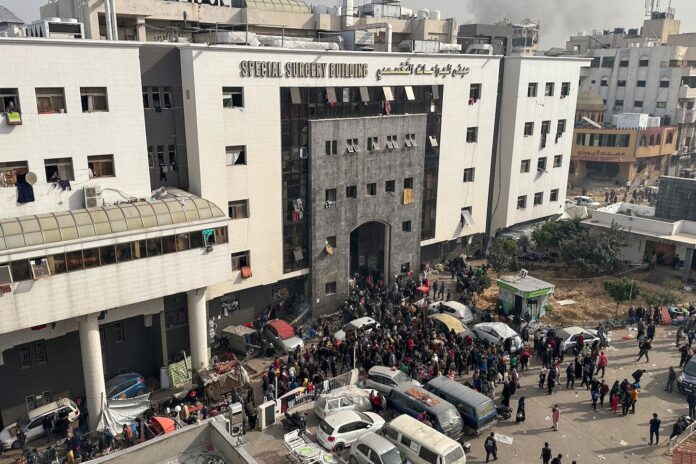The newly declassified information, obtained by U.S. spy agencies, shows that militants destroyed documents and electronics at the complex in advance of the Israel Defense Forces raid, according to U.S. officials, speaking on the condition of anonymity because of the matter’s sensitivity.
“We have information that continues to support our conclusion that Hamas and Palestinian Islamic Jihad used the al-Shifa hospital complex and sites beneath it to house command infrastructure, exercise certain command and control activities, store some weapons, and hold at least a few hostages,” said one official. Palestinian Islamic Jihad is another Gaza-based militant group, allied with Hamas in the fight against Israel but under separate command.
The U.S. intelligence assessment largely mirrored the Israeli military’s claims that al-Shifa was used as a command post.
Critics said Israel’s military operations against the complex, which housed Gaza’s largest and most advanced medical facility, were disproportionate to any threat posed by militants who may have been operating there. At least 40 patients — including four premature babies — died in the days leading up to the raid and in its aftermath, the United Nations said.
The hospital now functions at a minimal level, according to the World Health Organization.
The disclosure of the intelligence late Tuesday night follows a Washington Post investigation last month of whether the civilian harm caused by the IDF’s campaign against the hospital complex — encircling, besieging and ultimately raiding the facility and the tunnel beneath it — were proportionate to the assessed threat.
The Post’s examination, which included an analysis of open-source visuals, satellite imagery and publicly released IDF materials, found among other things that rooms connected to the tunnel network discovered by the IDF showed no immediate evidence of military use by Hamas and no evidence that the tunnels could be accessed from inside hospital wards.
The new details, recently declassified, were obtained from intelligence gathered by U.S. spy agencies after the IDF’s Nov. 15 raid, officials said. Some of it was gathered through technical means, they said.
Officials said in a release Tuesday night that Hamas militants had “largely evacuated” the hospital “days earlier” as the IDF approached. Last month, officials told The Post that “Hamas had been holding the hostages in the hospital compound until shortly before Israel went in.”
The details also support statements in November by National Security Council and Pentagon spokespeople that the two militant groups had used al-Shifa to conceal and support their military operations, including storing weapons and holding hostages.
State Department spokesman Matt Miller last month reiterated that the United States had evidence that Hamas was operating beneath the hospital before Israel attacked. He also addressed widespread criticism that the IDF had not provided sufficient proof that the hospital was being used as a command post. “I don’t think anyone should expect that a Hamas command and control center is going to look like the White House Situation Room. It’s a terrorist organization who is hiding itself underground behind civilians,” Miller said.
While U.S. officials say the intelligence community has “high confidence” in its assessment of al-Shifa’s use by Hamas, they have not publicly released visual or audio evidence. The IDF’s claims have also been challenged by a lack of conclusive proof.
“The U.S. intelligence community is confident in its judgment on this topic and has independently corroborated information” on Hamas and Palestinian Islamic Jihad’s use of the hospital complex “for a variety of purposes related to its campaign against Israel,” the first U.S. official said.
Officials would not elaborate on what type of electronics were destroyed, but the action could suggest that the militants were trying to conceal their presence or prevent Israel from obtaining equipment useful for intelligence purposes.
As the conflict enters its fourth month, Israel says it is withdrawing some troops from the Gaza Strip, where at least 22,000 Palestinians have been killed and 57,000 more injured in one of the most destructive military campaigns this century.
Israel has vowed to end Hamas rule in Gaza, after thousands of militants burst into Israel early on the morning of Oct. 7, killing at least 1,200 people and taking more than 230 hostage.
Israeli officials say they have degraded Hamas’s capabilities by killing thousands of its fighters, including commanders, and destroying portions of its underground tunnel network. But for the most part, the group’s most influential figures inside Gaza have proved elusive, with the whereabouts of the group’s leader, Yahya Sinwar, apparently unknown.
John Hudson in Washington contributed to this report.



